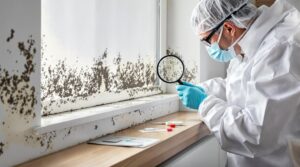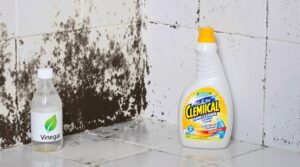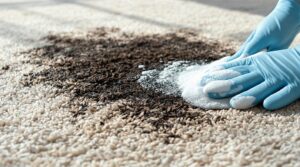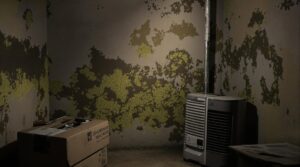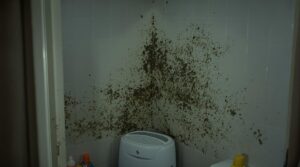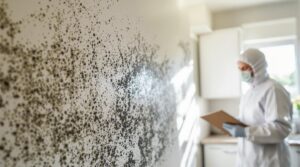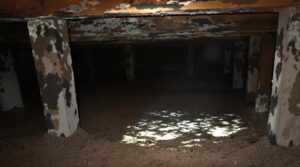Hydrogen peroxide effectively kills mold through an oxidative process that breaks down cellular structures. The chemical compound penetrates porous materials and disrupts mold cell walls by releasing oxygen molecules, which degrades essential proteins and DNA within the organism. A 3% concentration proves ideal for household applications when applied with proper safety equipment and ventilation protocols. Proper treatment requires 10-minute contact time and thorough scrubbing. Understanding the complete remediation process guarantees lasting results against future mold growth.
Key Takeaways
- Hydrogen peroxide effectively kills mold by breaking down cellular structures through oxidative reactions and oxygen molecule release.
- A 3% concentration of hydrogen peroxide is optimal for household mold treatment applications.
- The solution penetrates porous materials like wood and grout while degrading essential proteins and DNA within mold organisms.
- Treatment requires a 10-minute contact time, followed by scrubbing with a brush to remove visible mold.
- For safety, wear protective gear including gloves, goggles, and respiratory mask when applying hydrogen peroxide to treat mold.
Understanding How Hydrogen Peroxide Works Against Mold
When hydrogen peroxide comes into contact with mold, it initiates a powerful oxidative reaction that breaks down the organism's cellular structure through the release of oxygen molecules.
This oxidation mechanism disrupts the integrity of mold cell walls while simultaneously degrading essential proteins and DNA within the organism.
The cellular penetration capabilities of hydrogen peroxide make it particularly effective against mold growth, especially in porous materials such as wood and grout. Using a 3% concentration solution provides optimal effectiveness for household mold removal applications.
As the compound breaks down into water and oxygen, it lifts mold particles to the surface, reducing the risk of residual contamination. For optimal results, maintain a contact time of 10 minutes before wiping or scrubbing the treated area.
The decomposition process also guarantees that no harmful chemical residues remain after treatment.
The antimicrobial properties of hydrogen peroxide extend beyond mold elimination, as it effectively neutralizes various microorganisms, including bacteria and viruses that often coexist with mold colonies.
This thorough approach to microbial control makes hydrogen peroxide a reliable option for addressing fungal contamination in both residential and commercial settings.
The Science Behind Mold Growth and Treatment
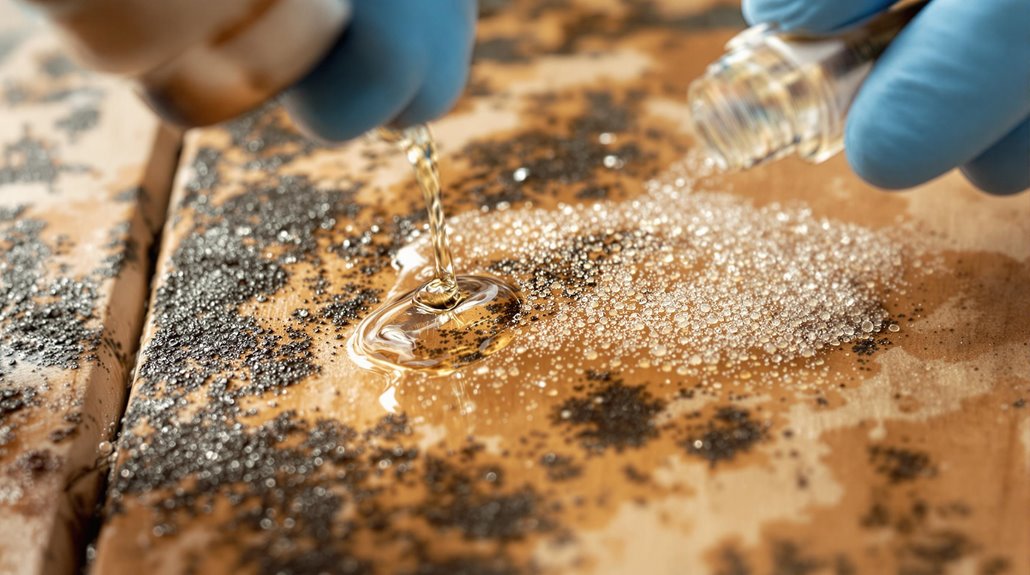
Understanding the fundamental requirements for mold proliferation is essential for effective treatment and prevention strategies. Mold growth depends on four critical factors: available spores, suitable food sources, appropriate temperature ranges, and sufficient moisture. Most mold species require relative humidity levels of at least 70% to thrive, with ideal growth occurring when humidity exceeds 80%. Mold colonies form within 24-48 hours of moisture exposure under optimal conditions.
Temperature plays a vital role in mold development, with growth inhibited below 40°F and above 100°F. Materials such as wood, drywall, and carpeting can serve as substrates when their moisture content exceeds specific thresholds; wood, for instance, becomes susceptible at 16% moisture content. Even trace amounts of skin oils and residues can provide sufficient nutrients to support mold growth on various surfaces.
The effectiveness of various treatment methods varies substantially. While bleach and detergent combinations demonstrate superior efficacy in reducing both spores and mycotoxins, other methods like gamma irradiation and steam cleaning show limited success. Hydrogen peroxide emerges as an effective treatment option, working by oxidizing mold cells and facilitating their removal from surfaces.
Step-by-Step Guide to Using Hydrogen Peroxide for Mold Removal
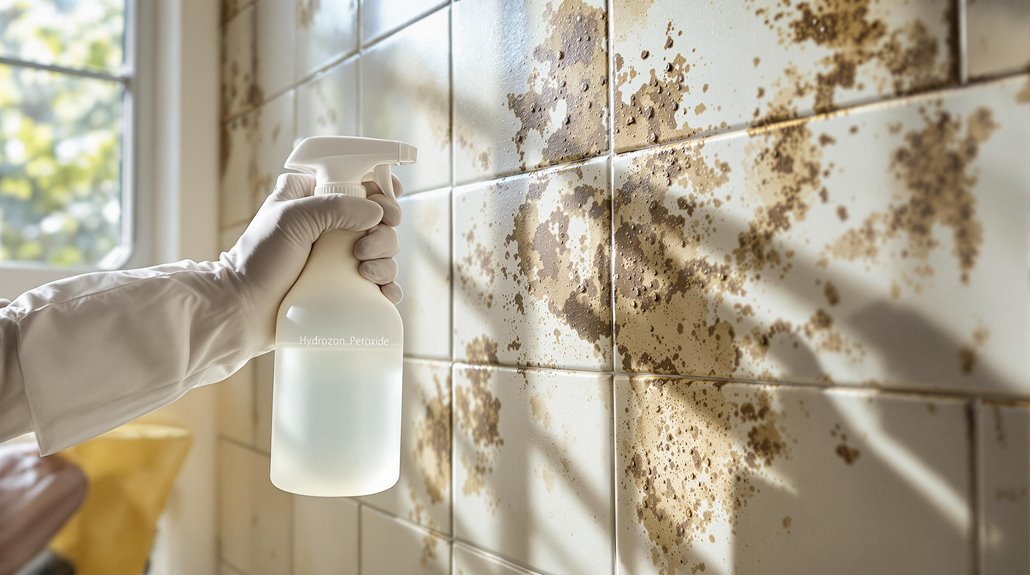
The successful removal of mold using hydrogen peroxide requires a systematic approach that encompasses proper preparation, application, and post-treatment procedures.
Initial steps include identifying suitable surfaces, guaranteeing proper ventilation, and gathering essential supplies such as a spray bottle, protective gear, and a 3% hydrogen peroxide solution. Professional evaluation must be conducted for any wet electrical components before treatment begins. Hydrogen peroxide's unique capability to break down membranes of mold cells makes it highly effective for this purpose.
The treatment process begins with proper saturation of the affected area using hydrogen peroxide, allowing it to penetrate for 10 minutes.
Thorough scrubbing with a brush or sponge follows to eliminate visible mold and stains. After wiping with a microfiber cloth, the surface requires complete rinsing and drying.
Post-treatment involves monitoring the area for recurring growth and implementing preventive measures.
These include addressing moisture sources, maintaining adequate ventilation, and considering surface sealants where appropriate. For extensive contamination or persistent issues, professional remediation services may be necessary to guarantee complete mold elimination.
Safety Precautions When Treating Mold With Hydrogen Peroxide
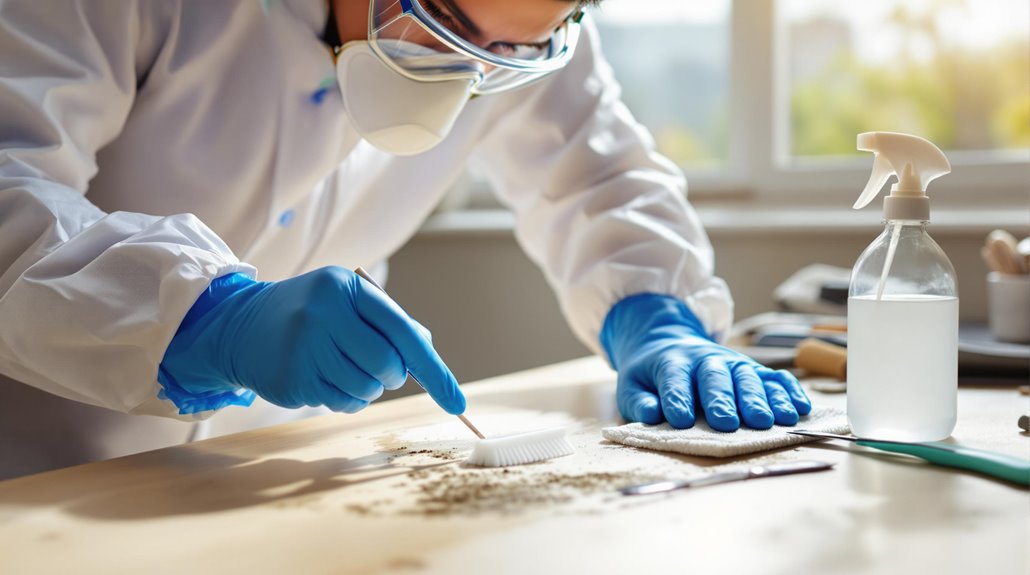
When handling hydrogen peroxide for mold treatment, proper protective equipment including gloves, eye protection, and respiratory gear is essential to prevent skin irritation, eye damage, and lung issues.
Adequate ventilation through open windows or fans helps minimize exposure to fumes during the treatment process.
Chemical cross-reactions pose significant risks, making it vital to avoid mixing hydrogen peroxide with other cleaning agents that could produce toxic compounds like peracetic acid.
Those with compromised immune systems should take extra precautions when treating mold due to increased health risks from exposure.
Use Protective Equipment Always
Safe handling of hydrogen peroxide for mold treatment requires complete protective equipment and strict adherence to safety protocols. Proper handling necessitates wearing specific protective gear and conducting equipment inspection before each use.
| Equipment | Purpose | Importance |
|---|---|---|
| Gloves | Prevents skin contact | Essential |
| Goggles | Protects eyes | Critical |
| Mask | Blocks spores/fumes | Mandatory |
The complete protective ensemble must include full skin coverage to prevent exposure to both mold spores and hydrogen peroxide. Users must carefully remove and clean all protective equipment after use according to manufacturer specifications to prevent cross-contamination. Special attention should be given to proper disposal of contaminated materials and thorough hand washing following treatment procedures. Professional mold remediation experts utilize HEPA air scrubbers to maintain safe air quality during treatment processes.
Ventilate Work Area Well
Proper ventilation serves as a critical safety measure when treating mold with hydrogen peroxide, requiring specific airflow management protocols to minimize spore dispersal.
Implementing strategic ventilation timing and airflow direction helps prevent the spread of mold spores throughout the structure.
The process requires positioning fans to exhaust air directly through windows while maintaining negative pressure in the work area.
Sealing off HVAC ducts and adjacent rooms with plastic barriers prevents cross-contamination. Windows should remain open throughout the treatment process, with fans continuing to operate until the area is completely dry.
To guarantee effectiveness, the ventilation system should create a continuous outward flow, directing potentially harmful spores away from living spaces.
This controlled airflow, combined with proper containment measures, substantially reduces the risk of spreading mold contamination to unaffected areas.
Maintaining -5 Pascals pressure in the workspace ensures proper containment and prevents spores from migrating to clean areas.
Avoid Chemical Cross-Reactions
Three fundamental safety principles govern the use of hydrogen peroxide for mold treatment: avoiding chemical mixing, utilizing proper protective equipment, and maintaining strict storage protocols.
Chemical caution is paramount when using hydrogen peroxide, as mixing it with other cleaning agents can produce hazardous results. The combination of hydrogen peroxide with vinegar creates peracetic acid, a toxic substance that irritates eyes, skin, and respiratory systems. Similarly, mixing dangers arise when hydrogen peroxide contacts bleach, resulting in increased corrosiveness and toxicity.
These chemical cross-reactions can release harmful fumes throughout the home, creating unpredictable and dangerous situations. To guarantee safety, hydrogen peroxide should be used exclusively as a standalone treatment for mold removal, stored in opaque containers away from light, and applied in well-ventilated areas using appropriate protective equipment. When treating extensive mold growth measuring over 1,000 spores/M3, professional remediation services should be contacted instead of attempting DIY chemical treatments.
Choosing the Right Concentration for Effective Mold Treatment
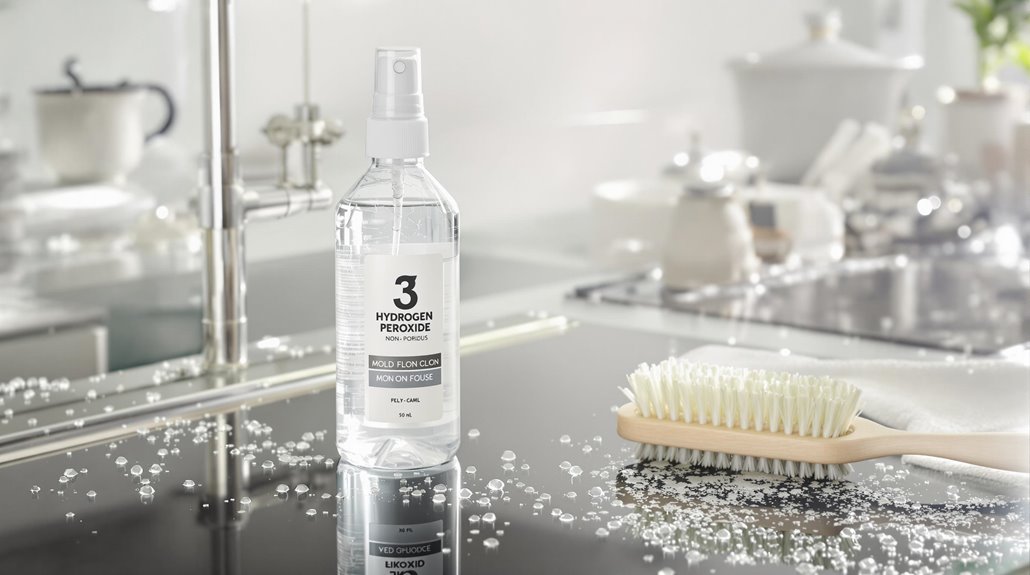
When treating household mold, selecting the appropriate concentration of hydrogen peroxide is essential for effectiveness. Research indicates that a 3% concentration provides ideal results for surface-level mold treatment while maintaining safety standards. This concentration has demonstrated consistent efficacy in inhibiting fungal growth across various non-porous surfaces.
Surface suitability plays a vital role in determining treatment success. While 3% hydrogen peroxide effectively eliminates mold on non-porous materials like glass, countertops, and walls, its concentration measurements become irrelevant on porous surfaces such as wood or drywall, where the solution cannot penetrate adequately.
Application requires spraying the 3% solution directly onto affected areas, allowing ten minutes of contact time, followed by mechanical removal with a brush or cloth. For extensive infestations exceeding 10 square feet or when treating porous materials, professional remediation services should be engaged, as they possess specialized equipment and expertise for thorough mold abatement. During professional remediation, HEPA vacuuming and wire brushing are essential steps for complete mold removal.
Common Mistakes to Avoid When Using Hydrogen Peroxide
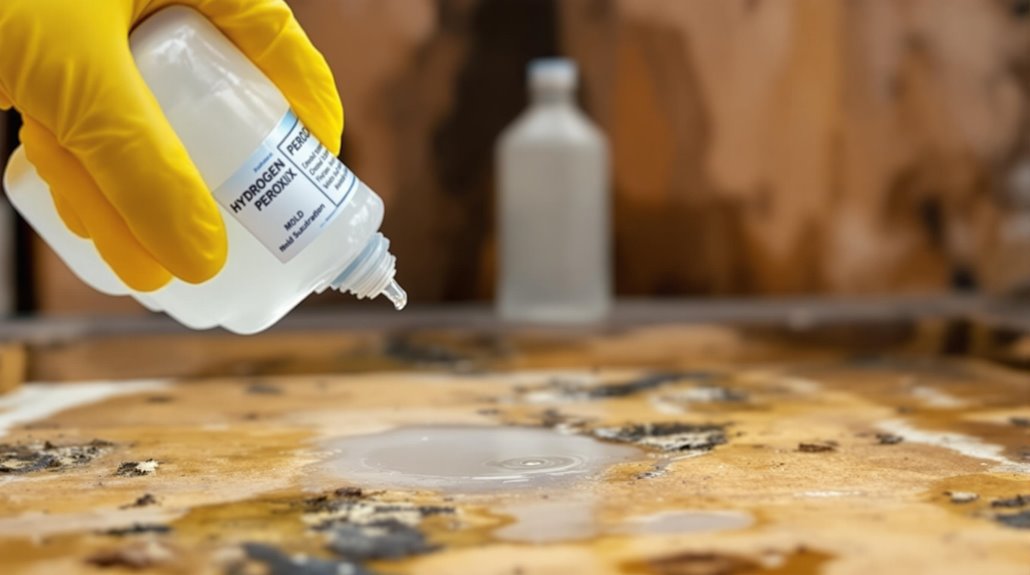
A critical safety concern when using hydrogen peroxide for mold treatment is the inadvertent mixing with other cleaning agents, which can produce dangerous chemical reactions and toxic fumes.
Combining hydrogen peroxide with vinegar creates peracetic acid, a hazardous compound that poses significant risks to respiratory health and skin safety.
Another common error involves over-saturating porous materials like wood and fabric with hydrogen peroxide, which can lead to material damage and incomplete mold remediation due to the solution's limited penetration capabilities.
Mixing With Other Cleaners
Safety considerations must be prioritized when using hydrogen peroxide as a mold-fighting agent, particularly regarding its interaction with other cleaning products. Combining hydrogen peroxide with common household cleaners can trigger dangerous chemical reactions and create serious mixing hazards.
Specifically, mixing hydrogen peroxide with vinegar produces corrosive peracetic acid, while combinations with bleach or ammonia release toxic gases. Contact with alcohol can result in flammable compounds.
To prevent harmful reactions, hydrogen peroxide should be used independently or with safe alternatives like baking soda. Users must carefully read product labels and follow manufacturer guidelines.
When addressing mold issues, it's advisable to either use hydrogen peroxide alone or consult professional mold remediation services for extensive infestations, rather than experimenting with potentially dangerous cleaning combinations.
For serious black mold infestations, HEPA-filtered respirators and proper protective equipment are essential when applying any cleaning solutions. In addition to using HEPA-filtered respirators, it’s crucial to ensure that the affected area is well-ventilated to minimize inhalation of spores. Homeowners should also familiarize themselves with effective methods for how to eliminate black mold to prevent future infestations. Utilizing specialized cleaning solutions designed for mold removal can significantly improve the efficacy of the cleanup process and safeguard both health and property.
Over-Saturating Porous Materials
Over-saturating porous materials represents one of the most critical mistakes users make when applying hydrogen peroxide for mold treatment. Excessive surface saturation can lead to deeper penetration of both the cleaning agent and mold spores, potentially causing extensive material damage. This is particularly problematic in materials like drywall, wood, and carpet, where over-saturation creates conditions conducive to continued mold growth. For large affected areas over 300 square feet, professional mold remediation typically costs up to $7,500 for proper treatment.
| Material Type | Saturation Risk | Recommended Approach |
|---|---|---|
| Drywall | High | Minimal application |
| Wood | High | Spot treatment only |
| Carpet | Severe | Professional cleaning |
| Tile | Low | Standard application |
| Concrete | Moderate | Controlled application |
To prevent material degradation, users should apply hydrogen peroxide judiciously, focusing on surface-level treatment of non-porous materials. For extensive mold issues in porous surfaces, professional remediation offers a more effective solution.
When to Call Professional Mold Remediation Services
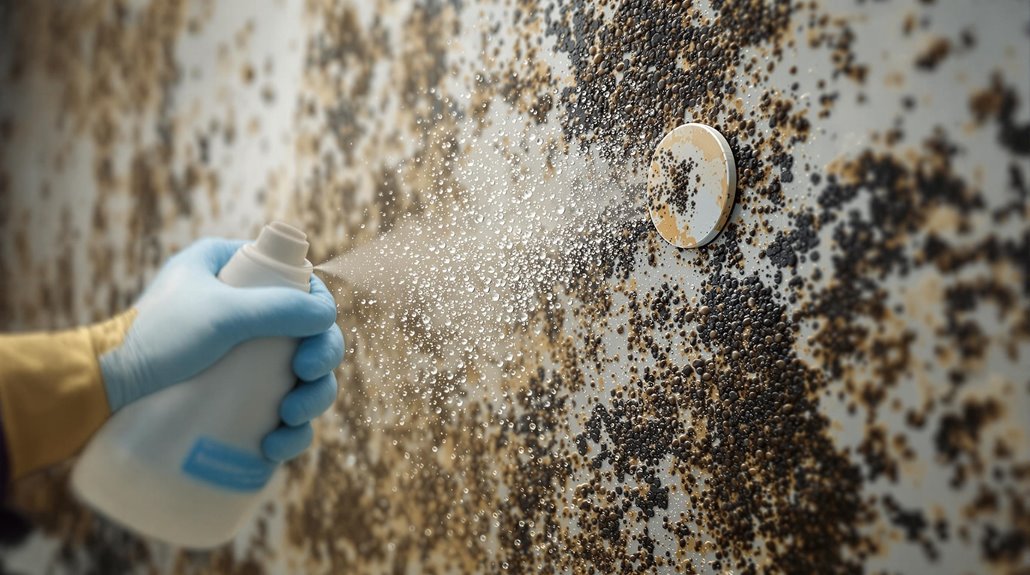
Professional mold remediation services become necessary when mold infestations exceed the scope of DIY cleaning methods or pose significant health risks. Extensive infestations can develop within 24 to 72 hours following water intrusion, requiring immediate assessment by certified technicians who can properly identify and address the underlying moisture sources.
Professional remediation teams utilize specialized equipment and advanced techniques to detect hidden mold growth and guarantee complete structural drying. They implement proper containment procedures and employ protective gear to prevent cross-contamination during the removal process.
In cases involving HVAC systems or flood damage containing hazardous substances, expert intervention becomes vital for safe remediation.
These services also facilitate insurance claims and provide thorough restoration plans. IICRC-certified technicians conduct thorough testing, develop targeted treatment strategies, and verify successful remediation through third-party air quality testing, guaranteeing the complete elimination of mold spores and associated health hazards.
Prevention Tips to Keep Mold From Returning
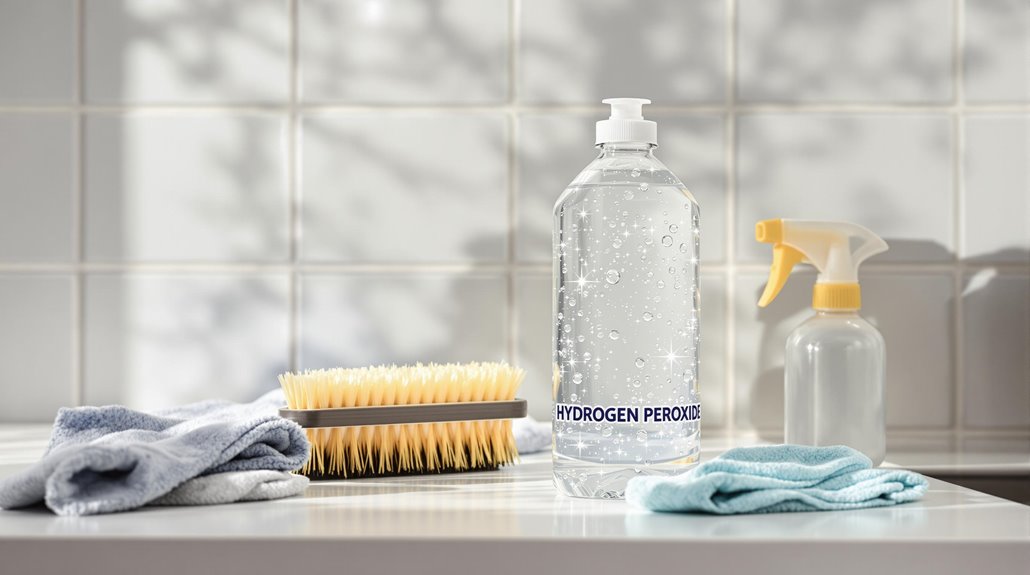
Effective mold prevention requires a thorough approach focused on controlling moisture levels and maintaining structural integrity.
Implementing exhaustive moisture control strategies includes maintaining indoor humidity between 30-50%, installing proper ventilation systems, and promptly addressing water accumulation from any source.
Critical preventive measures involve protecting the building envelope through regular roof maintenance, proper gutter function, and ground sloping away from the foundation.
Installing waterproof barriers beneath roofing materials and using water-resistant building materials in moisture-prone areas substantially reduce water infiltration risks. Additionally, utilizing mold-resistant products, such as specialized paint, drywall, and finishing materials, creates an inhospitable environment for mold growth.
Regular inspection and maintenance protocols should include checking for leaks, ensuring proper ventilation in all spaces, and monitoring crawl spaces and attics.
Installing vapor barriers and maintaining adequate air circulation in non-living areas further strengthens the home's defense against recurring mold issues.
The Benefits Of Consulting A Public Adjuster

Professional public adjusters offer critical expertise in maneuvering through complex insurance claims related to mold damage and water-related issues.
These licensed professionals conduct thorough damage assessments, document evidence extensively, and negotiate directly with insurance companies to maximize claim settlements.
Research indicates that policyholders who work with public adjusters often receive higher settlement amounts due to the adjusters' specialized knowledge of insurance policies and industry practices.
Expertise In Insurance Claims
A public adjuster's expertise in insurance claims provides invaluable benefits for policyholders maneuvering through complex claim processes. Their thorough understanding of insurance protocols and claims expertise enables them to interpret policies effectively while identifying potential coverage limitations and exclusions.
| Expertise Area | Direct Benefits |
|---|---|
| Policy Analysis | Identification of overlooked damages and benefits |
| Claim Management | Professional handling of documentation and negotiations |
| Settlement Strategy | Maximized compensation through strategic advocacy |
Through their professional knowledge of insurance regulations and procedures, public adjusters guarantee that claims are properly documented and presented. Their ability to navigate intricate policy language and negotiate with insurance companies often results in higher settlements, while simultaneously reducing the stress and time burden on policyholders during the recovery process.
Objective Damage Assessment
Complete damage assessment conducted by public adjusters provides property owners with an unbiased evaluation of mold-related impacts. Through thorough property assessment protocols, adjusters utilize specialized equipment to detect both visible and concealed mold infiltration, ensuring accurate damage scope documentation.
The assessment process encompasses thorough inspections of all potentially affected areas, including wall cavities, subflooring, and HVAC systems.
Public adjusters meticulously document findings through detailed photographs and descriptions, creating thorough claims that reflect actual repair costs. This systematic approach enables adjusters to identify the full extent of contamination while recommending preventive measures against future mold growth.
The resulting documentation serves as vital evidence during insurance negotiations, supporting property owners in securing appropriate compensation for remediation efforts and necessary structural repairs.
Streamlined Claim Process
Public adjusters substantially streamline the insurance claims process for property owners facing mold-related damages. Through process optimization, they reduce the administrative burden by managing documentation, negotiations, and complex policy requirements. Their expertise accelerates claim resolution while ensuring thorough coverage of all damages.
The claim acceleration benefits extend beyond time savings. Public adjusters leverage their extensive knowledge and network of specialists, including engineers and contractors, to conduct thorough assessments.
This systematic approach results in detailed documentation that supports claim validity and prevents underestimation of damages. By handling all aspects of the claim process, public adjusters enable property owners to focus on property management while ensuring accurate settlement amounts through professional advocacy and negotiation with insurance companies.
Higher Claim Payouts & Settlements
Statistical evidence consistently demonstrates that engaging public adjusters leads to substantially higher insurance claim settlements for property owners affected by mold damage.
Payment analysis reveals that homeowners working with public adjusters receive settlements averaging $22,266, compared to $18,659 for those handling claims independently.
Through settlement optimization techniques and professional representation, adjusters maximize coverage by ensuring all eligible damages are documented and properly valued.
- Complete damage assessment and documentation leads to more accurate claim valuations
- Professional negotiation tactics help overcome common insurance company settlement reduction strategies
- Contingency-based services align the adjuster's interests with maximizing the policyholder's payout
Their expertise in policy interpretation and claims management effectively reduces out-of-pocket expenses while securing larger settlements, making their services particularly valuable for complex mold-related claims.
About The Public Claims Adjusters Network (PCAN)

The well-established Public Claims Adjusters Network (PCAN) stands as a complete service provider in the insurance industry, offering over 40 years of expertise in claims handling and adjustment. Their network capabilities encompass experienced daily and catastrophic (CAT) adjusters, alongside extensive call center support, ensuring efficient management throughout the claims lifecycle.
PCAN delivers tailored solutions for policyholders, handling everything from initial loss notification to final settlement. Their public adjusters, hired directly by insured individuals, provide critical services including claim preparation, coverage interpretation, and settlement negotiation.
Operating under strict guidelines, these adjusters cannot solicit business during losses or between 6 p.m. and 8 a.m., maintaining professional standards. Their contracts explicitly detail fee structures, which are paid by the insured rather than insurance companies.
Client testimonials consistently validate PCAN's professional approach, highlighting their expertise in transforming claims management processes and delivering reliable, customized solutions for unique challenges.
Frequently Asked Questions
Can Hydrogen Peroxide Remove Mold Stains From Clothes and Fabrics?
Hydrogen peroxide effectively removes mold stains from fabrics, with success rates varying based on stain intensity and fabric type. Regular 1-3% solutions minimize fabric discoloration while eliminating most mold-related discoloration.
How Long Does Hydrogen Peroxide Remain Effective After Opening the Bottle?
Opened hydrogen peroxide maintains effectiveness for approximately six months under proper storage conditions. Degradation rate increases with light exposure, temperature fluctuations, and contamination, necessitating dark, cool storage for maximum preservation.
Will Hydrogen Peroxide Damage or Discolor My Grout Between Tiles?
Like waves eroding shorelines, excessive hydrogen peroxide use can lead to grout degradation. When properly diluted (1:1 ratio) and used monthly, surface discoloration risks remain minimal on most grout types.
Can I Use Hydrogen Peroxide to Kill Mold on Houseplants?
Diluted hydrogen peroxide effectively eliminates mold on houseplants when used as a soil treatment. The solution guarantees plant safety while oxidizing fungal growth and improving soil aeration through controlled applications.
Does Hydrogen Peroxide Work Against Black Mold in Air Ducts?
Hydrogen peroxide is not recommended for treating black mold in ductwork. Safety and ventilation requirements make proper application impossible, and the chemical cannot effectively reach or eliminate deep-seated mold within air ducts.
References
- https://www.homehealthyhomes.com/services/mold-services/mold-information/how-to-kill-mold/
- https://www.ndsu.edu/agriculture/ag-hub/publications/efficacy-peroxide-based-products-management-white-mold-soybeans-and-dry-beans
- https://www.homecleanse.com/does-hydrogen-peroxide-get-rid-of-mold/
- https://www.cleanerguys.com/can-hydrogen-peroxide-kill-mold-the-ultimate-answer-from-pros/
- https://www.icecleaning.co.uk/blog/does-hydrogen-peroxide-kill-mould
- https://wearetulsi.com/blog/does-hydrogen-peroxide-kill-mold
- https://greenorchardgroup.com/what-kills-mold/
- https://www.healthline.com/health/does-hydrogen-peroxide-kill-mold
- https://clearrestore.com/hydrogen-peroxide-and-mold/
- https://energyresearch.ucf.edu/consumer/buildings/building-science-basics/mold-growth/
